
Photo by Michael Mosbach
Some stories just want to begin where they end. Like songs, days, journeys, lifetimes, and even love affairs, everything is colored by how things turn out. If any of those stories ends badly, the rest of it probably won’t shine too brightly in memory. For example, if this pillar of basalt on the northwestern shore of Nova Scotia had responded to my little joke by falling on me, it wouldn’t be just a metaphor. It would be a variation on the classic definition of comedy and tragedy: if the rock falls on Michael, it’s comedy. If it falls on me, it’s tragedy.
The date was July 13, 2013, a day off before our second show in Halifax, the last one on the penultimate run of our Clockwork Angels tour. The formation is called Balancing Rock, and in retrospect, it has come to seem like a multi-faceted symbol—both universal and personal. Everyone knows what it’s like to have days like these—when you’re standing in a hard place and pushing against an unyielding wall of stone. Also, for this reporter, nothing could be more representative of the dynamics of my life than “balancing rock.” Thirdly, the actual moment, as opposed to the symbol, echoes a time and place in a previous life that ended badly, and thus does not include any bright memories.
In September, 1996, on the occasion of my forty-fourth birthday (“Ah, were we ever so young?”), my late wife Jackie gave me a birthday card in which she wrote her gift to me: “Seven days of freedom.”
Brutus and I, living with our families in Toronto then, and in the second year of our infatuation with adventure touring on motorized two-wheelers, discussed where we might be able to ride to and from in that seven days. It happened that around that time I was watching Canada’s Weather Network (as you do), and as part of a series of “Canadian Postcards,” the above attraction was pictured, near Tiverton, Nova Scotia. Brutus and I could get to Nova Scotia and back in seven days, and I thought, “Well—let’s ride to Tiverton. Make sure that rock is still balancing.”
So, way back in 1996, Brutus planned a typically circuitous route to lead us up to Lac St. Jean in Quebec, down across the Gaspé Peninisula to New Brunswick’s Grand Manan Island, then onto the ferry from Saint John to Digby, Nova Scotia. Following the narrow peninsula at Nova Scotia’s northwestern tip to a small ferry over to Tiverton, we hiked through the boggy woods of black spruce and tamarack to Balancing Rock, and saw that it was good.

Seventeen years later, Brutus and I—taking Michael along with us this time—were drawn there by the same spurious quest, to see that the legendary rock was still balancing.
Because other people might not bother to check on things like that.
They might think they have something more important to do “On Days Like These.”
Which brings us back to our title. For me, that song title is a perfect fit for pretty much every day—evoking many stories, and many memories. Few songs have haunted my helmet the way that one has—maybe only Jeff Buckley’s masterly rendition of “Hallelujah” (especially on rainy days) and Sinatra’s versions of “Gentle on My Mind” and “Everything Happens to Me” come close.
The song itself is a recent discovery, and only because I saw it mentioned in two different British classic car magazines. The journalists were test-driving Lamborghinis from the ’60s, and both of them happened to remark that they felt like they should be hearing “On Days Like These,” by Matt Monro.
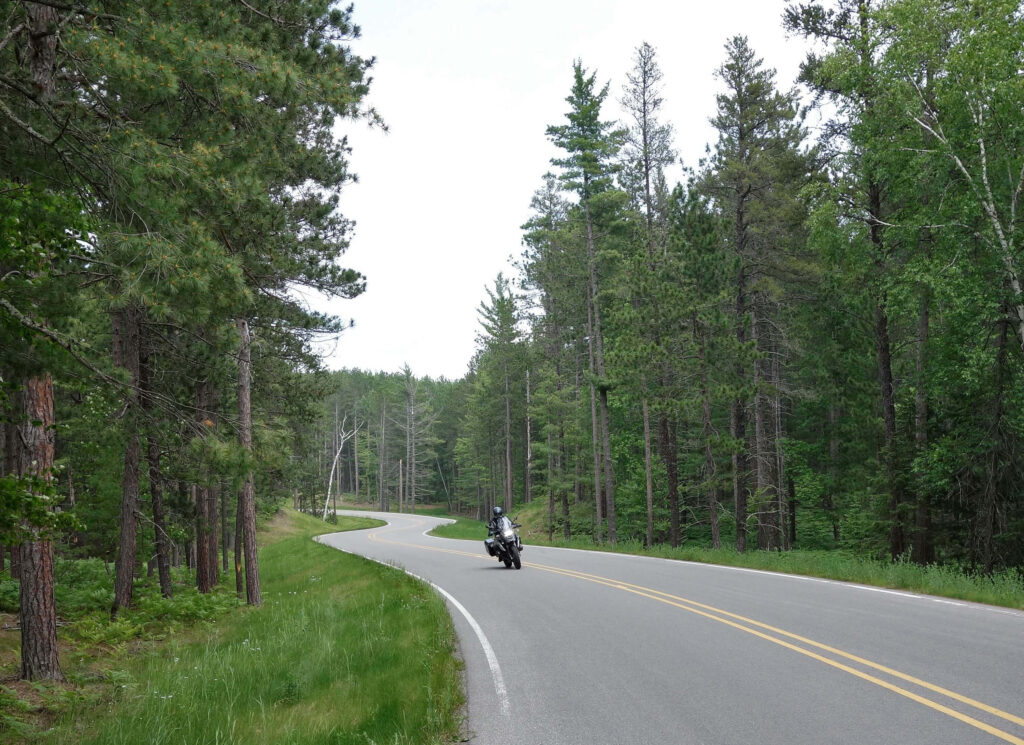
Matt Monro, I knew, was a British singer in the Sinatra style. In the ’60s he had a few hits in North America, like “Portrait of My Love” and “Born Free,” and I remember riding in my father’s pickup truck with the radio on (as always), and hearing Matt Monro described by the DJ as “the English Frank Sinatra.” My father, a lifelong Sinatra fan, as I have since become, scoffed out loud at that. But these days, Dad and I agree that Matt Monro was actually very good, and is a story in himself—discovered by George Martin, the Beatles’ producer, he had a successful career internationally, until at the age of just fifty-four, he was struck down by stupid cancer.
At that time, Frank Sinatra himself said, “His pitch was right on the nose, his word enunciations letter perfect, his understanding of a song thorough. He will be missed very much not only by myself, but by his fans all over the world.”
I hadn’t heard of the song “On Days Like These,” but in context of the car magazine stories, my guess was that the lyrics must express some joyous feeling of in-the-moment existence—like driving a classic Lamborghini through the English countryside. However, the connection was both more esoteric and more dramatic. In the opening scene of the original version of The Italian Job (1969), actor Rossano Brazzi is pictured driving a bright orange Lamborghini Miura (considered the original “supercar,” with its low, swoopy bodywork and mid-mounted V12) in the Swiss Alps, near the old Saint Bernard Pass. On-car cameras captured the Miura’s perfect handling of the winding, narrow pavement, twisting through the snow-streaked mountains. The high-pitched howl of the V12 blipping down the gears segués into the opening bars of the song.
With a melancholy air over a minor chordal soundscape and a lilting tempo, Matt Monro sings one line in Italian to set the romantic mood, “Questi giorni quando vieni il bel sole.”
(These days when the beautiful sun comes up.)
Then into the first verse:
On days like these, when skies are blue, and fields are green
I look around and think of all that might have been
Then I hear sweet music float around my head
As I recall the many things we left unsaid
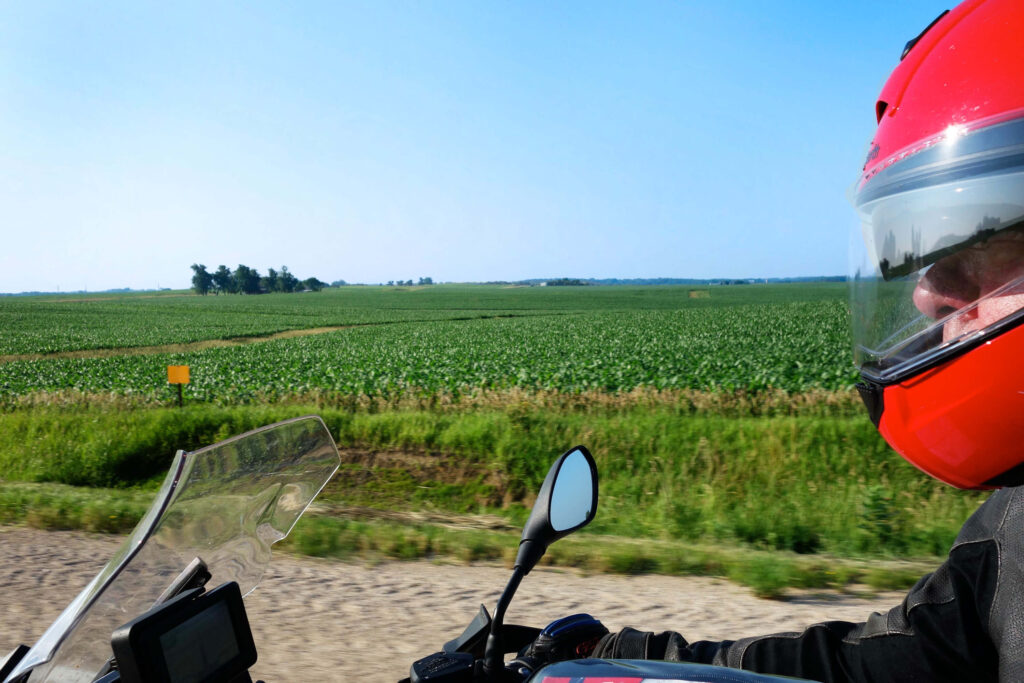
So, it’s the classic “lament for lost love,” wistful and nostalgic. (The music is by the great Quincy Jones, and the lyrics by Matt Monro’s manager, if you can imagine that, Don Black, who also set words to memorable movie themes like “To Sir With Love” and “The World is Not Enough.”) In the song’s next part, the voice and orchestration step up with more emotion.
It’s on days like these, that I remember
Singing songs and drinking wine
While your eyes played games with mine
The second verse falls back to the lower register, dynamically and emotionally, once again quietly sentimental about a memory that he likes to wish might be shared.
On days like these, I wonder what became of you
Maybe today you’re singing songs with someone new
I’d like to think you’re walking by those willow trees
Remembering the love we knew—on days like these
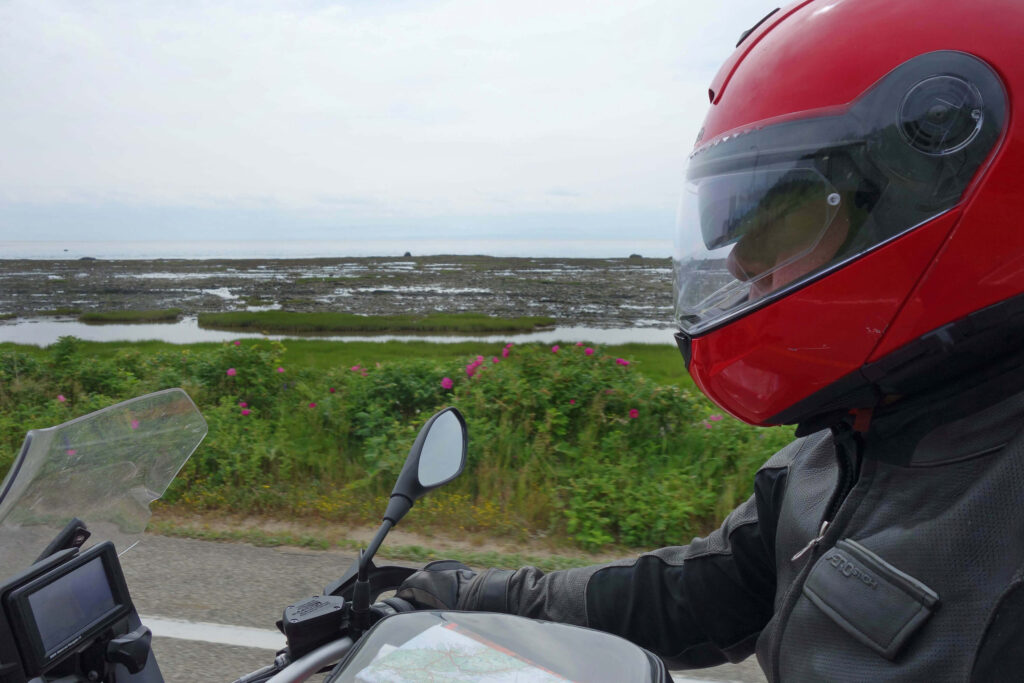
In the movie, the song fades out just as the Miura enters a dark tunnel. To describe what follows would be a “spoiler,” but in any case, apart from the artful driving footage, in one of the world’s most spectacular landscapes, it was the song that captivated me.
Every riding day during this run of the tour, through New York, Pennsylvania, Ohio, Indiana, Iowa, Illinois, Wisconsin, Michigan’s Upper Peninsula, and across Ontario, Quebec, New Brunswick, and Nova Scotia, that song played in my helmet. (Talking about that phenomenon with other riders, we agree that a song can be mentally playing while you’re cruising along, then when you need to concentrate on more demanding traffic or road conditions, the music goes into “pause.” When mental space allows, the song of the day will resume at exactly the same place. That would be one advantage of listening to that “analog” playback as opposed to digital earbuds—it cannot distract you at the wrong time.)
“On Days Like These” was not like what is called an “earworm,” some annoying old song that you can’t get out of your head, but a combination of words and music that always rang true. Every day seemed like “that day”—perfectly appropriate for that song, playing over and over in my inner jukebox.
“On Days Like These” . . .

And here is another story that begins at the end. Your correspondent rests on a plastic chair in Newberry, Michigan, comfortably settled in front of a motel room and enjoying a post-ride plastic cup of The Macallan. Following what had been a very “full,” adventurous, and dramatic day in Michigan’s Upper Peninsula, the drink—and the moment—tasted especially delicious.
After the previous night’s show in Milwaukee, I asked bus driver Dave to carry us north to Green Bay, where he parked at our usual show-night accommodations, the Château Walmart. That would set us up for a good ride across the Upper Peninsula, then down to the next show in Grand Rapids.
Michael and I had crossed the U.P. several times, as recently as the previous fall (see “The Better Angels”), so in Milwaukee I had scanned the Michigan state map looking for some different routes. I highlighted a section of unpaved road leading toward Pictured Rocks National Lakeshore, but as happens to us fairly often, when Michael tried to translate that route into his computer, the mapping program, “Mother,” did not totally agree with the paper map, and interpreted its own version.
Such “interpretations” have led Michael and me on many an unexpected adventure . . .
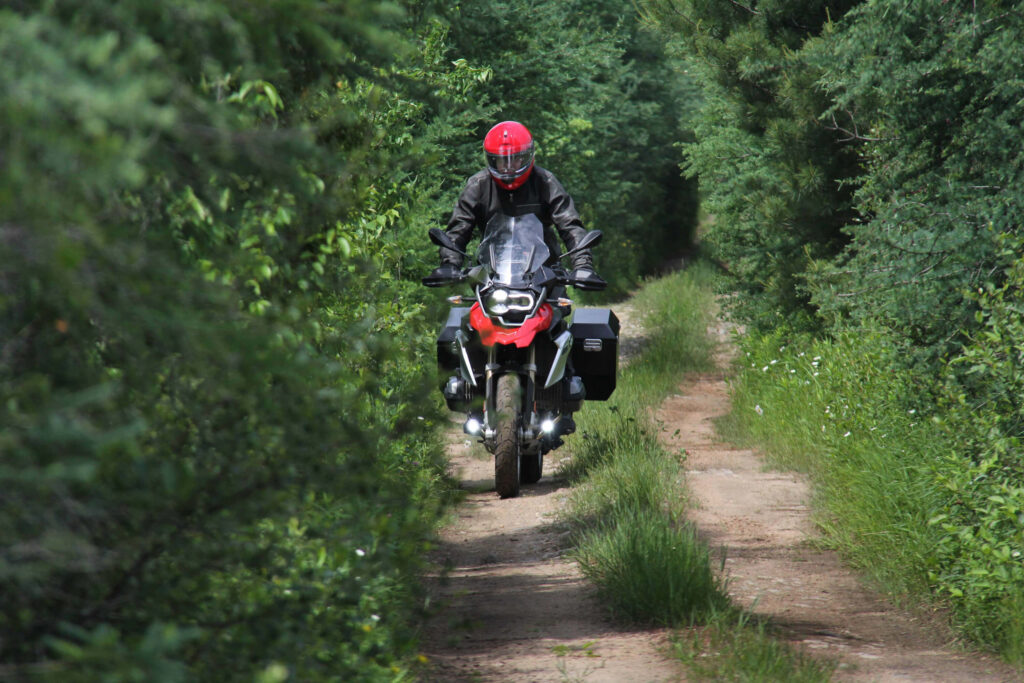
We always call those parts of an upcoming ride the “mystery roads.” Michael would inform me that Mother didn’t seem to agree with the line I had traced, and we couldn’t know if we would get a “normal” unpaved road of graded gravel, or a bumpy trail through any kind of obstacles—mud, loose gravel, deep ruts and puddles, studded boulders, washed-out bridges, or long stretches of sand (a serious hazard on our heavy bikes—see “Adventures in the Wild West”). So we always had to be prepared to improvise.
Our mystery road on that day in the Upper Peninsula began pleasantly enough, a gravel logging road winding through the scrubby forest of mixed second-growth pines, tamaracks, and leafy hardwoods. It gradually degenerated to the narrow little track pictured above, with grass in the middle and both sides overgrown to where we sometimes had both elbows in the leaves and needles. ATVs had left occasional deep ruts on damper ground, though not recently—maybe during the previous fall’s hunting season. But we kept moving without difficulty, and weren’t yet concerned.
When people ask about the off-pavement abilities of our BMW GS motorcycles, I always say, “We can handle a bad road, or a good trail.” And indeed, occasional signs seemed to indicated that we were now on snowmobile trails. We encountered a few water crossings, which are always dramatic photo opportunities, and once I had made it through, I would wave Michael to a stop behind me so I could get out my camera.
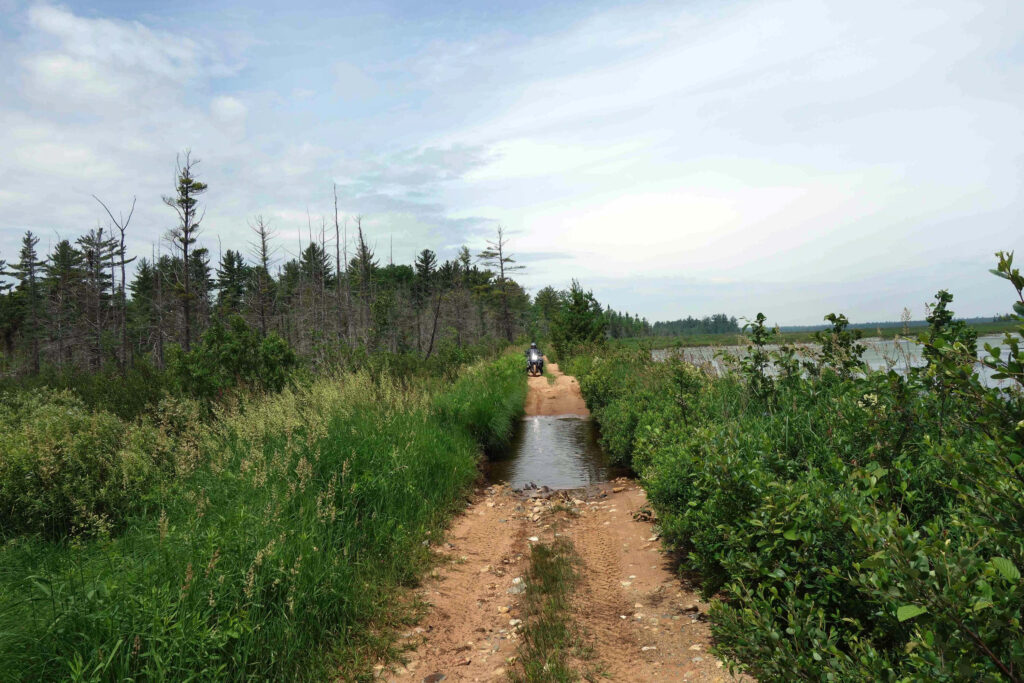
Around this point things started to get a little rougher, and for a while we didn’t take any photographs. I have pointed out before that when things get really bad, the last thing you want to do is stop for pictures—you just keep going and try to get out of there. And all the while, the farther you go, you know that if you have to turn back, every obstacle you have overcome becomes one you will have to face again. It is not a fun feeling.
We encountered some stretches of slimy mud and deep sand that sent the bikes slewing around, forcing us to put our feet down for balance. Always keeping an eye on my mirrors, and even stopping to look back after particularly bad stretches, I saw Michael go down in a mudhole, his out-of-control bike plunging sideways into the trailside brush. Parking my bike on its sidestand and dashing back to help, I saw his gray machine laying on its side in the green underbrush, and heard the engine still running. Then it suddenly died, and I heard only silence. That was not what I wanted to hear just then, and I couldn’t see Michael at all. Clambering around the fallen bike, I saw his upper body and helmet. He was on his back among the saplings, thrashing around a little on his elbows.
That was also an alarming sight, and I said, “Are you all right?”
“Yes,” he said doubtfully, “I think so. But I can’t get up because the bike is on my leg.”
At moments like that, your brain races with adrenaline and imagination—me picturing his leg being burned by the muffler, or broken by the weight of the bike, and us stranded in that very isolated place. However, moments like that also give you superhuman strength, and I quickly lifted the rear of the bike away from Michael.
He struggled slowly to his feet, testing out his arms and legs, and giving his helmeted head a quick shake. “Just doing a systems check,” he said.
After I had seen each of Michael’s limbs move at least once, we turned to his fallen motorcycle. In the tangled undergrowth and slippery mud, it was hard to get it on its wheels again, and to work it back over toward the trail. Both of us were nervous about whether it would start again—but it fired right up, ready to face the next challenge.
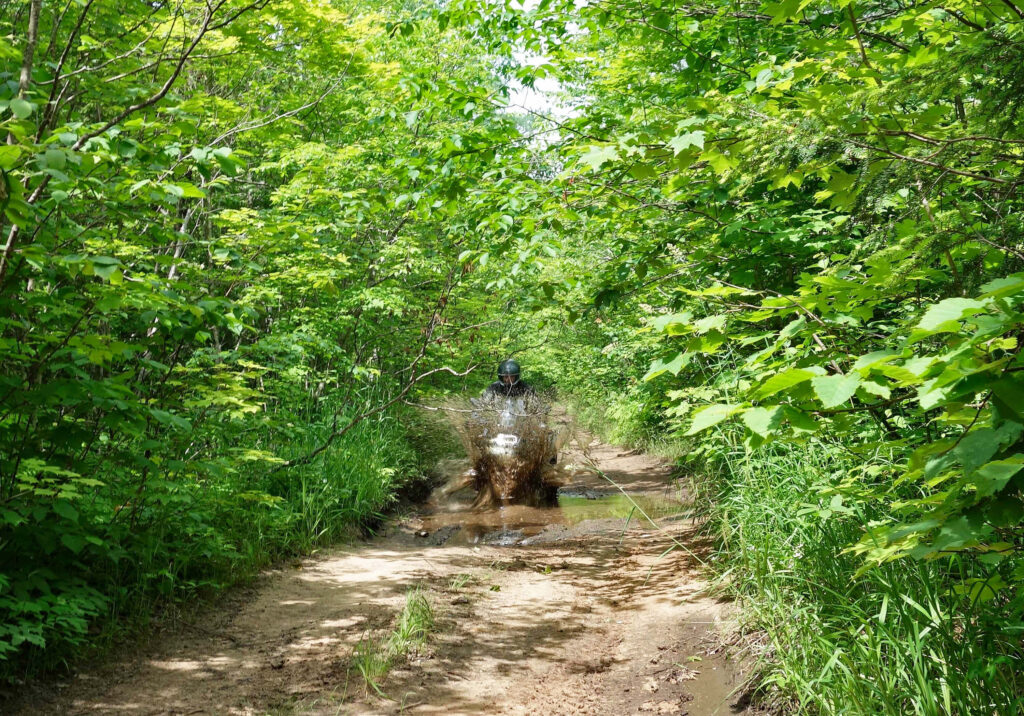
The next time it was my turn—my front wheel plowing into deep sand while the rear caught a rut, and just like that, the bike was down. I was necessarily riding slowly, and fell clear of the bike, without injury. Once again, we got my bike back on its wheels, and carried on.
(Both of our GSes were fairly new at that time—mine just past its first major service—so they were receiving their true “baptism by fire” as West Side Beemer Boyz mounts.)
At one water crossing, my bike plunged into the deepest water I had ever tried to cross, a brown flood that reached up over the cylinder heads. I just managed to power through, then parked on the other side to shoot Michael’s passage—warning him about the depth.
With that in mind, Michael decided to take the center line, between the ruts left by ATVs, figuring the water would be shallower there. While that was true, the flaw in that plan was that when Michael did start to skid and needed to put a foot down, he had only deeper water on either side. Even a non-rider can guess what is about to happen here . . .
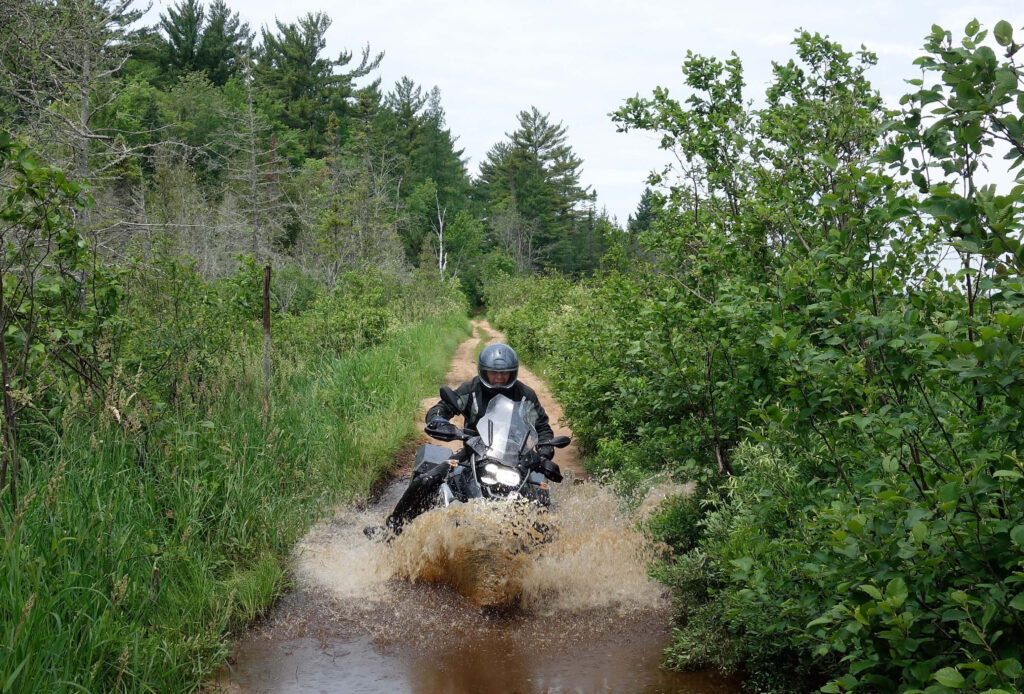
(A close-up of his face is particularly telling!) At least Michael was able to steer the out-of-control machine to the side again, into the underbrush rather than the deep water—which might well have been terminal for the engine. I waded into the brown pond, ignoring the water flooding into my boots, and once again we wrestled his bike out of the bush and onto its wheels and got it restarted.
Every time we stopped like that, blackflies and mosquitoes swarmed around us in ever-thickening clouds. As I had experienced in the Canadian Arctic and Alaska, we had to keep our helmet faceshields down whenever we were stationary. (I had laughed to notice a dot on the Michigan map named Slapneck—I knew what they were talking about.) It would be a terrible place to be stranded for any length of time.
And still, we couldn’t know if this snowmobile trail would get worse—become truly impassable in some way, sending us back on an ever-longer and more inhospitable route. One trailside sign read, “OHV and Snowmobile Trail, Not Maintained for Passenger Vehicle Traffic.” Another warned snowmobilers about the “Winding Trail.” Finally, we had to laugh out loud at seeing a sign that represented the end of our trials: “Caution: Highway.”
That warning was for the wintertime snowmobilers, of course—because for us two-wheelers, we were pretty glad to meet that highway. It led us first to a gas station, which we needed by that time, then eastward on some winding pavement around Pictured Rocks toward the town of Grand Marais—the best motorcycle roads in Michigan, I would venture.
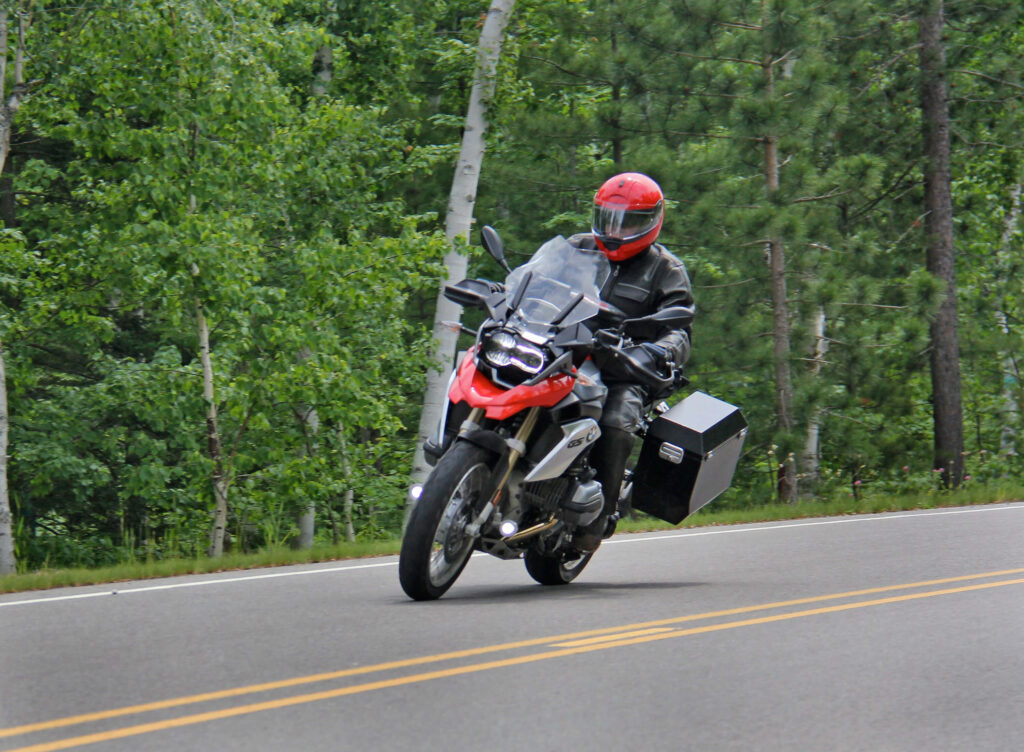
We had stayed in the village of Newberry before—a typical northern hamlet that was a seasonal destination for hunters, snowmobilers, fishermen, and summer vacationers. I couldn’t find the motel we had stayed at before (sad to report, the mom-and-pop places are steadily disappearing, year by year), but we settled at the similar Knollwood Motel, as pictured in the previous post-ride portrait. It was the first proper park-outside-your-door motel we had stayed at since the Mayberry Motor Inn, back in May (see “The Sweet Science”). After an hour or two of sitting outside and watching the cars, trucks, and occasional packs of loud motorcycles (you know the kind) pass on the highway, and sharing our photos from the day, we dined at the attached restaurant on T-bone steaks and corner-store wine. We were exhausted and sore, but supremely content—I was still hearing, “On Days Like These.”
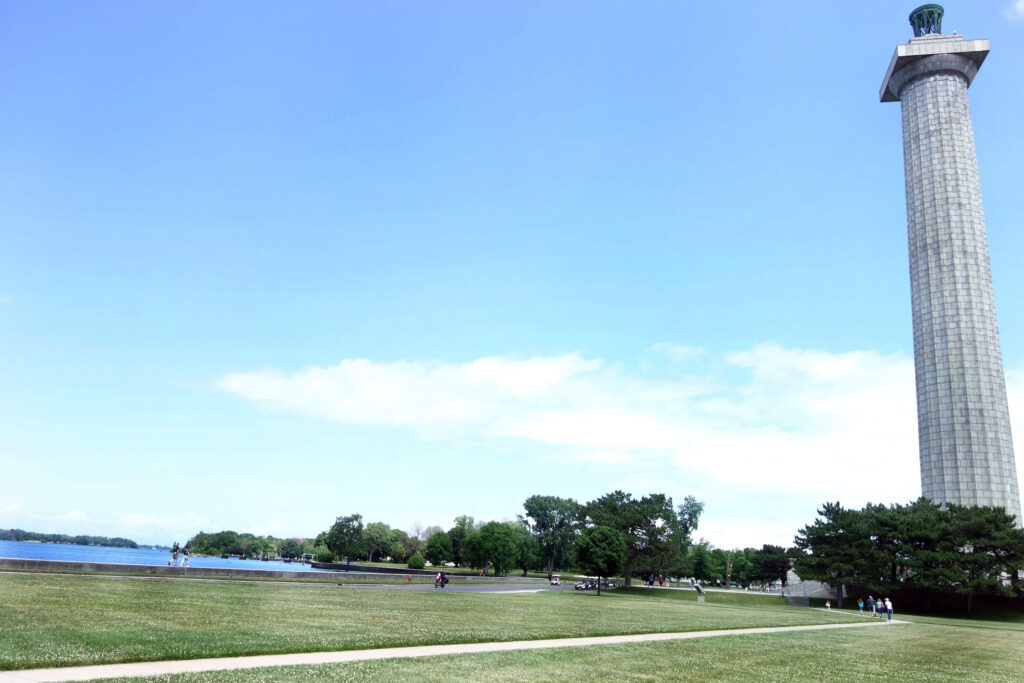
Here is another story that begins at the ending, historically speaking. The setting is Put-in-Bay, Ohio, in the Bass Islands, a short ferry ride out in Lake Erie. The monument is called “Perry’s Victory and International Peace Memorial,” and is one of the tallest in the United States (higher than the Statue of Liberty, for example—that’s little old me on my motorcycle in the middle). The column, along with three enormous flagpoles nearby that display huge American, Canadian, and British flags, commemorates a great naval battle that took place just offshore (won by the Americans, led by Commodore Oliver Hazard Perry), a war that is largely forgotten except by Canadians, the War of 1812.
I grew up on the other side of that lake, in the Niagara Peninsula between Lake Erie and Lake Ontario. That area was the scene of several of the land battles in that war—Queenston Heights and Lundy’s Lane, for example—so the War of 1812 is perhaps more familiar to me than even to most other Canadians. The history is long and complicated, but briefly, the Americans declared war on Great Britain because of trade restrictions brought about by the Napoleonic Wars, American merchant sailors being brutally kidnapped into the Royal Navy (the notorious “press gangs”), British support of Native tribes against American expansion, and a possible (though hotly debated to this day) American interest in annexing Canada. (There was no “Canada” then, only a British colony until 1867, but Canadians still like to think “they” beat back the Americans. The truth seems to be that the Americans hoped to hold Canada temporarily, as a kind of “hostage,” to reinforce their other demands. The war was settled in 1814 by the Treaty of Ghent, which left all borders as they were, so the Americans did not seem very interested in annexing Canada.)
Historical highlights of the War of 1812 that are better remembered by Americans include the Battle of New Orleans (hit song by Johnny Horton in 1959), the burning of the White House and Capitol, the Battle of Baltimore (which inspired “The Star-Spangled Banner”), and the Battle of Lake Erie. That naval encounter alone is quite a story, for interested readers. (In tangents that might not be of general interest, I have learned to be content to plant a seed of curiosity, and let it grow where it will.)

Photo by Michael Mosbach

